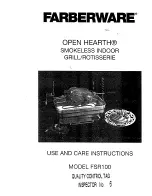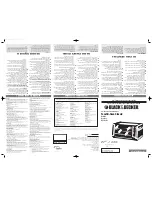
ANDREWS COMBIfl o
53
GB
6.1.1.2 SPARK ELECTRODE AND FLAME SENSE ELECTRODE
In order to maintain optimum reliability, it is recommended that both sets of electrodes are replaced every two
years regardless of their condition. It is recommended that these electrodes are best inspected when they are still
in place and the entire heat exchanger door has been removed (see 6.1.1.1), but can also be inspected by carrying
out the following :
• Turn off the appliance and pull off the electrode lead(s).
• Unscrew the two screws retaining the spark electrode in position and carefully withdraw.
• The spark gap should be 5.0 mm ± 0.5mm.
• Undo the two screws retaining the fl ame sensing electrode.
• Withdraw and inspect for wear or damage.
• Replace electrode(s) if older than 24 months or if worn or damaged.
• Assembly is the reverse, ensure the gasket is undamaged and correctly placed.
6.1.1.3. AIR DUCT & FLUE SEALS
A visual inspection should establish there are no leaks around any of the seals, including the fl exible air duct to
the venturi. Replace if there is any doubt as to the integrity of the seals.
6.1.1.4. CONDENSATE PIPEWORK & SYPHON
Inspect all joints in the condensate pipework for leaks, repair/replace parts if any defects are found. The lower
bowl of the syphon can be unscrewed, examined and cleaned. Check its connection to the heat exchanger and
pipework for leaks.
6.1.1.5. GAS RATE & COMBUSTION
The gas rate and combustion fl ue analysis must be carried out when the appliance is operating at maximum load-
ing. See Section 5.2 for details on how to check and adjust the CO
2 .
To check, re-establish gas and electricity supply and then operate each heat engine for at least 5 minutes. If ad-
justment is required remove the cover over the throttle screw and turn anti-clockwise to increase CO
2
, clockwise
to decrease.
Allow at least a minute between adjustments to obtain stable readings. The gas rate will be correct when the CO
and CO
2
fi gures are to specifi cation.
6.1.1.6. FLUSH & INSPECT STORAGE TANK
Flush the water storage tank by opening the drainage tap. Let the water fl ow out of the water heater until no more
chalk residue comes out with the water. In areas with hard water, it is necessary to fl ush out the water heater more
frequently.
If the water heater is to be drained for any reason,fi rst take the water heater out of operation by isolating the power
and then proceed as follows: Turn off the water tap in the cold water supply. Open one of the warm water taps that
can be found at a point higher than the water heater in order to bleed the warm water pipe section. If the water
heater is set up above the level of the drainage points, it will be necessary to open the warm water connection to
let the appliance run empty. Open the drainage tap of the water heater so the appliance drains empty. Be careful,
the water fl owing out can be very hot!
The storage tank should be inspected annually and cleaned if required. To gain access, fi rst drain the tank as above.
Disconnect any pipework connections to allow removal of the Tank Inspection Hatch at the top of the unit on RH
side. Remove foam insulation to reveal Tank Inspection Hatch. Loosen nut on Tank Inspection Hatch to remove
Hatch and inspect storage tank.
Summary of Contents for COMBIflo 100/300
Page 9: ...ANDREWS COMBIflo 7 GB 3 1 GENERAL DIMENSIONS CONNECTIONS 3 0 TECHNICAL DATA ...
Page 12: ...ANDREWS COMBIflo 10 GB 3 4 APPLICATION EXAMPLES Single Heating Circuit Simple ...
Page 13: ...ANDREWS COMBIflo 11 GB Single Heating Circuit Immersion DHW Circulation pump ...
Page 16: ...ANDREWS COMBIflo 14 GB Heating Circuit External 0 10V control ...
Page 17: ...ANDREWS COMBIflo 15 GB BMS INTERNET CONNECTIONS ...
Page 18: ...ANDREWS COMBIflo 16 GB 3 5 WIRING DIAGRAMS PCB 1 ...
Page 19: ...ANDREWS COMBIflo 17 GB PCB 2 3 ...
















































